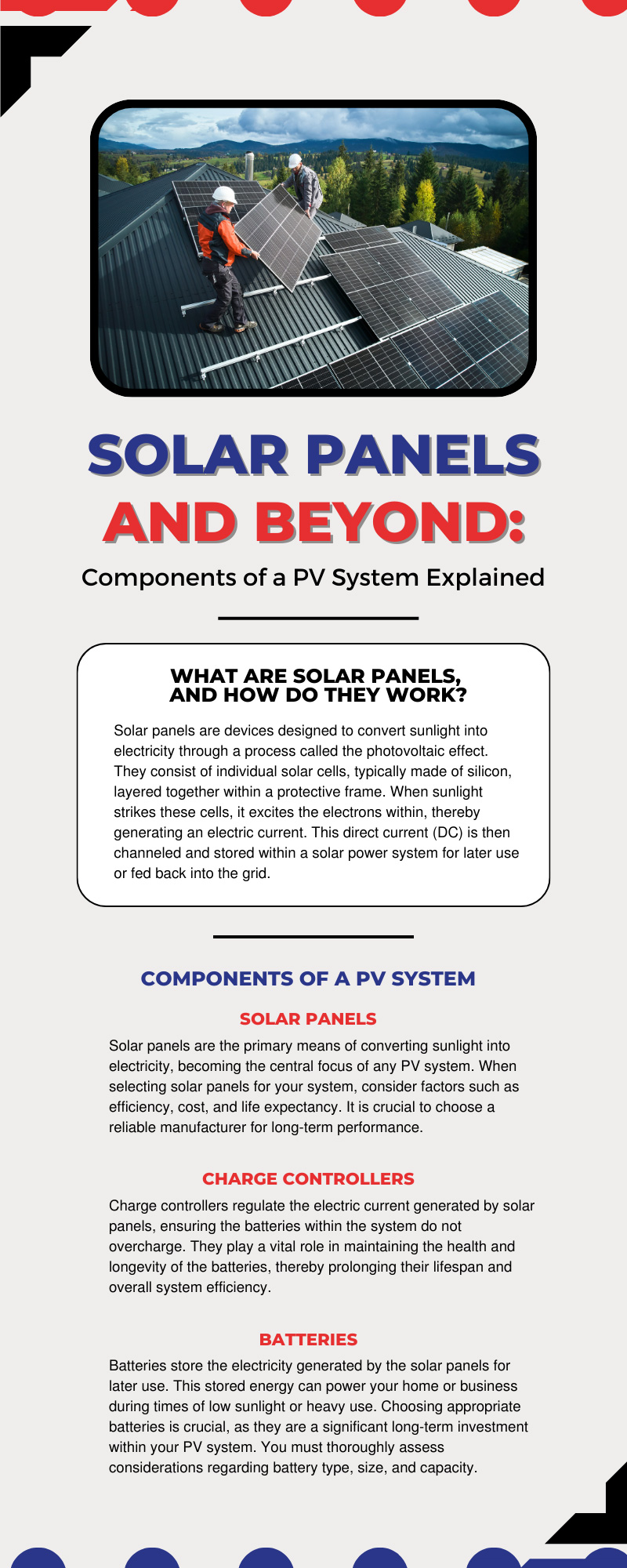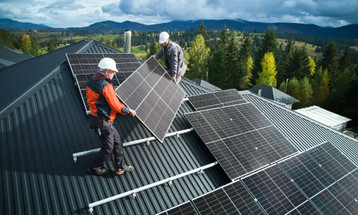Nov 30th 2023
Solar Panels and Beyond: Components of a PV System Explained
Solar panel systems are becoming more common sights around the US and the world, with many commercial businesses and residential homes making the switch. If you’re interested in getting a photovoltaic (PV) solar system for your business or home, you should review our guide that explains the key components of a PV system, from solar panels and beyond!
What Are Solar Panels, and How Do They Work?
Solar panels are devices designed to convert sunlight into electricity through a process called the photovoltaic effect. They consist of individual solar cells, typically made of silicon, layered together within a protective frame. When sunlight strikes these cells, it excites the electrons within, thereby generating an electric current. This direct current (DC) is then channeled and stored within a solar power system for later use or fed back into the grid.
As the core component of a photovoltaic (PV) system, solar panels play an essential role in turning sunlight into green, sustainable energy. With advancements in technology and increased efficiency, solar panels are becoming an increasingly popular choice for businesses and homeowners seeking clean, renewable power sources.
The Benefits of Having a Photovoltaic System
Before we get into more of the details of PV systems, let’s discuss what these solar panel systems offer to businesses and homeowners.
Cost Savings
Solar panels can substantially lower or even eliminate your reliance on traditional energy sources. This means lower utility bills and potentially even earning money by selling excess energy back to the grid. Additionally, with advancements in technology and government incentives, the initial investment in a solar panel system has become more affordable, making it a financially viable option for businesses and homeowners.
Environmental Impact
Another significant benefit of photovoltaic systems is their positive impact on the environment. Solar energy is a clean and renewable source of power, meaning it produces no harmful emissions or pollution. By reducing our reliance on fossil fuels, solar panels can help combat climate change and contribute to a more sustainable future for generations to come. This makes it an attractive choice for environmentally conscious individuals and businesses.
Energy Independence
Having a photovoltaic system also offers the benefit of energy independence. By generating your own electricity, you will no longer be subject to utility companies’ fluctuating prices or potential power outages. In some cases, solar panels can even provide backup power during emergencies, ensuring you have a reliable source of electricity when you need it most.
Components of a PV System
Now that you see the many advantages of a PV system for your home or business, we’ll explain the key components of a solar panel system, including charge controllers and backup systems.
Solar Panels
As mentioned, solar panels are the primary means of converting sunlight into electricity, becoming the central focus of any PV system. When selecting solar panels for your system, consider factors such as efficiency, cost, and life expectancy. It is crucial to choose a reliable manufacturer for long-term performance.
Charge Controllers
Charge controllers regulate the electric current generated by solar panels, ensuring the batteries within the system do not overcharge. They play a vital role in maintaining the health and longevity of the batteries, thereby prolonging their lifespan and overall system efficiency.
Batteries
Batteries store the electricity generated by the solar panels for later use. This stored energy can power your home or business during times of low sunlight or heavy use. Choosing appropriate batteries is crucial, as they are a significant long-term investment within your PV system. You must thoroughly assess considerations regarding battery type, size, and capacity.
Inverters
Inverters convert the direct current (DC) produced by solar panels into alternating current (AC), which is suitable for use by households and businesses. As an essential part of any PV system, quality inverters not only ensure the energy harvested is utilized efficiently but also protect the system from potential damage or hazards.
Labels
Properly labeled solar equipment ensures installers, maintenance workers, and inspectors can quickly and accurately identify components and their specifications. Solar panel labels provide a durable and long-lasting means of communication, meeting necessary compliance standards while bolstering safety.
Backup Systems for PV Systems
A key aspect of a solar PV system that should never be overlooked is the backup system that will boot up in the event of an outage or damage to the solar panels. There are generally two options for businesses and homeowners for backup PV systems: batteries or backup generators.
Backup Batteries
Backup batteries provide a means of storing excess energy generated by solar panels for later use, making them an essential component in any PV system. During times of low sunlight or heavy electricity use, backup batteries can power a home or business, providing an uninterrupted energy supply. Additionally, backup batteries can also serve as a backup power source during emergencies when grid power is unavailable.
Backup Generators
Backup generators can serve as a reliable power source for PV systems in case of emergencies or extended periods of low sunlight. They can also supplement solar energy during times of high electricity demand. When selecting a backup generator, consider factors such as fuel type, cost, and noise levels.
What Is Net Metering and How Does It Work
Net Energy Metering (NEM) is a billing system often used for homes and businesses with solar installations. It allows property owners to receive credit for any surplus electricity that is generated by their PV systems and fed back into the grid. By measuring the difference between energy consumption and solar production, net metering ensures customers only pay for the net amount of electricity they use.
NEM 2.0 and 3.0
NEM has been a policy in place for several years now, but it is continually evolving. The most recent version of this policy, known as NEM 3.0, brings significant changes that solar panel owners should be aware of. Under NEM 2.0, solar panel owners were credited at the full retail rate for any surplus electricity they generated and sent back to the grid. However, under NEM 3.0, this credit will be reduced over time as more solar installations are added to the grid.
Additionally, NEM 2.0 allowed solar panel owners to receive a one-time payment for any excess credits accumulated at the end of the year. However, under NEM 3.0, this payment will be eliminated, and excess credits will simply roll over into the following year.
Different Options for Solar Installation
There are several options available for installing solar panels, depending on the specific needs and requirements of your property. These include rooftop installations, ground-mounted systems, and tracking systems that follow the sun’s movement throughout the day to allow for maximum efficiency. Consult a professional installer to determine the best option for your PV system.
Label Your PV System Properly With Get Solar Labels
Now, you should better understand the key mechanisms of a PV solar system. As discussed, some of the most important components of a solar panel system are warning labels and placards. Get Solar Labels offers high-quality engraved solar labels that are durable enough to last years. If your system needs new labels or you’re installing new panels, get the labels you need at Get Solar Labels today!


